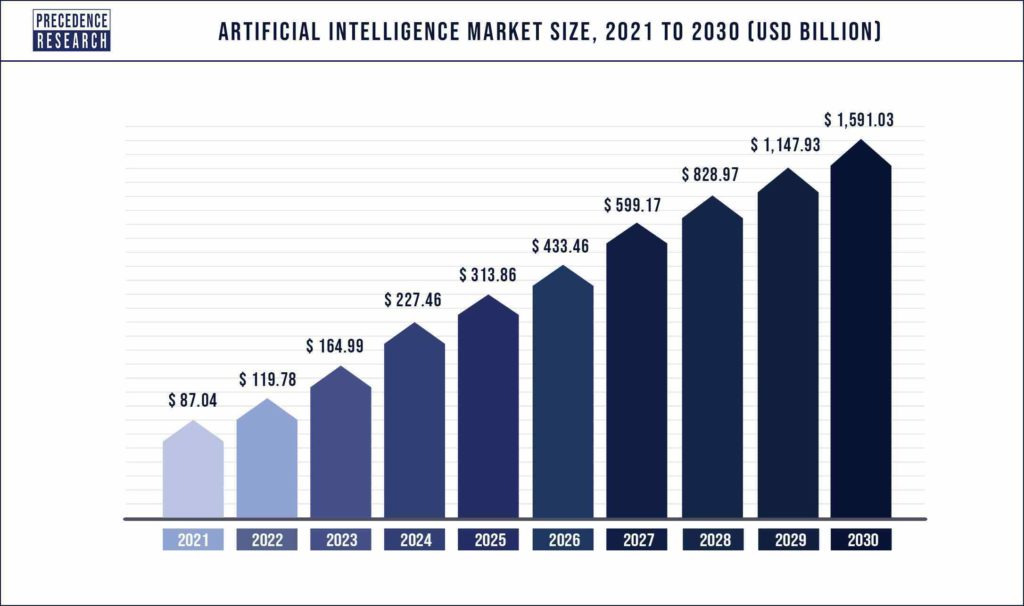Artificial intelligence can get a bad rap.
As automation, AI, and machine learning take over tasks traditionally done by people, we worry about becoming replaceable. We worry about our future job security, our place in the world, and the loss of that all-important human touch. And those are just the intellectual concerns. Many movies and novels have touched on the subject of artificial intelligence–from machines becoming tragically self-aware, to humans becoming subservient to machines.
Whilst these scenarios are of course fictionalized, AI is still treated with mistrust and derision. That’s manageable in industries such as car manufacturing or video conference security, but education is a much more loaded subject.
Education is one of the most vital cornerstones of our society, and developments in education are not to be taken lightly. Adding something new and controversial like artificial intelligence into the mix is always going to be a challenge.
This challenge can be met, though. The more we understand about AI, the less frightening it becomes. The more we can showcase its benefits to our society, the more welcomed it will be.
So how does AI really work?
Artificial intelligence is a field of study that seeks to create technology that can think and solve problems. It utilizes machine learning to analyze inputted data and output solutions, predictions, or further learning. Ultimately, the goal of AI is to mimic the critical thinking capabilities of the human mind. With enough data and powerful enough technology, pioneers of AI can build neural networks that learn, grow, and help us solve some of the most difficult problems.
It can sound a little like science fiction. So how do educators make AI a genuine asset in education? How do we prove to the world that artificial intelligence is the next important technological leap in learning?
Let’s take a look at some of the practical ways AI can (and in some ways already does) assist educators.
Freeing up time
Teachers don’t simply teach; they’re responsible for administrative tasks, too. Admin can be a huge time sink, can stress out already overworked teachers, and can be subject to human error.
One major benefit of AI is automation. Inputting and analyzing student data, scheduling and monitoring assignments, and creating reports can all be done by computers. In a digital testing scenario, AI-controlled remote proctoring can be used by educators to free up their precious time and allow them to focus more on planning lessons for their students.
Grading
Another admin task, teachers spend a lot of time and energy on grading assignments and tests. These tasks, too, can be subject to time restraints, stress, and human error. AI is already used in grading tests–with some positive and some negative results. A machine can already understand spelling, grammar, and engagement to mark a basic test efficiently. As machine learning becomes more sophisticated, AI will be able to understand context, nuance, and tone as well.
That’s a lot of grading tests and essays that teachers will be free of.
Personalizing learning
The more we learn about education, the more we realize not all students learn the same way. Individual students have individual needs, but it can be almost impossible to meet those needs when dealing with large classes and not enough staff. It’s a dilemma many teachers face every day: feeling like some students are falling behind, whether through neurodivergence, disability, or requiring a different learning style.
Artificial intelligence can help close that gap. For example, computer adaptive testing can assess each individual student’s needs by analyzing students’ previous answers and adjust the assessment to suit their skill level. Whilst all students are learning the same subjects, each student can have a personalized work set that complements their learning style and strengthens their specific weaknesses.
Creating educational content
AI can already write content. Sometimes, it’s painfully obvious, but more sophisticated systems are adept at writing content that reads like a person wrote it. With sophisticated machine learning, that content can be fact-based and educational.
Textbooks are expensive to write, publish, and purchase. Using technology to write educational content eliminates some of the cost to both the creators and the students.
Bolstering home learning
From COVID-19 forcing students into remote learning to the growing popularity of online courses, learning at home has become the norm for many. Things like video conferencing and remote testing have become vital to students, and these technologies contain aspects of AI already. But artificial intelligence can be an even bigger boon to remote learning.
Many institutions already use online assessment platforms to help carry out exams and other assessments. They are especially useful for students learning from home and can not attend an examination in person. They offer administrative support to teachers and can take on a lot of the burden of marking. They can even alter the level of the exams to suit a student’s individual needs, providing a more personalized assessment experience.
Solving problems
This is the goal of machine learning. Inputting data into a system, allowing the algorithm to learn from that data, and then having that system offer solutions or predictions.
In education, this could mean better decision-making based on amounts of data the human mind couldn’t ever hold. Using assessment data, educators can understand student strengths and weaknesses, pinpointing learning interventions while they are still relevant to the curriculum.
Transforming courses
Machine learning’s ability to absorb and analyze data can work to improve lesson plans, tests, and even whole curriculums. For example, a large number of students keep failing one specific question on a test. But why? There are so many possible answers, and human beings might spend vast amounts of time going over mountains of data to find the solution.
Is the question worded poorly? Is the expected answer too rigid? Is the question representative of the curriculum being taught that year? Do students have all the knowledge they need from their studies to answer it?
It’s a lot to consider.
AI can take massive amounts of data, process it, and help to find a solution. This can cut down on time spent tweaking courses and curriculums, as well as making better and more coherent tests.
Improving accessibility
Unfortunately, not everyone has access to a decent education. All around the world, many lack the ability to attend school due to poverty, illness, disability, isolation, or any other disadvantages out of their control. And if they can attend school, their circumstances often leave them falling behind other students.
AI can improve accessibility using processes such as blended learning, where each student is treated as an individual with unique needs that can be catered to. Instead of fitting all students into an educational box–regardless of the shape–education can be designed around students instead. Artificial intelligence is necessary for this to work. Many of the tools we’ve already talked about–personalization, remote learning, and problem-solving–require AI to aid teachers in figuring out students’ individual needs.
There are other tools to aid in accessibility, too. For students with certain disabilities, lesson transcribing using speech recognition technology can help them keep up with classes. Real-time language translation can help anyone from anywhere in the world take the courses they want, regardless of language barriers. Remote learning using VR technology offers students with mobility or location issues the ability to attend class in a way that feels personal.
But it’s not all positive news
Like all emerging technologies, artificial intelligence has its drawbacks. We can’t discuss how to make AI a genuine asset in education without mentioning the problems.
Many worry that mass adoption of artificial intelligence will eradicate the human touch. In education, that fear is amplified; the thought of cold, heartless machines teaching children their ABCs is a little eerie. But AI doesn’t work to supplant humans, only to automate the jobs we find tedious and support our more important tasks. It’s a tool, not a replacement, and it’s meant to work in lockstep with us to build a better world.
And there are more practical concerns. Online security and privacy are currently hot topics, and many are worried that advanced tech like AI only magnifies the risk of hacking, personal data breaches, and invasions of privacy. If mass adoption of AI is to happen, security professionals will have to work hard to soothe users’ fears.
Yet artificial intelligence marches on
AI isn’t going anywhere. In fact, the uses of AI just keep on growing.

All industries have benefited from artificial intelligence, and education is no different. From improving the quality of education to narrowing the gap in its accessibility, AI can work alongside a human touch to support the next generation of scientists, creatives, and educators.
